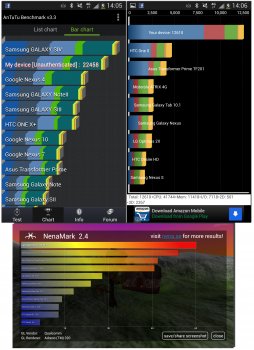
Samsung Galaxy S4 found to use benchmark boosting app to increase performance scores
In recent times, we have all lay witnessed to a sort of spec arms race, sparked by smartphone OEM’s doing whatever they can to trump the other, and gain valuable market share. As consumers, we’ve helped feed into this, demanding our devices add more cores with every iterations, and even higher ppi’s than the last. If you needed further proof that this has gotten out of hand, take a look at what was just uncovered.
Tipped by @AndreiF in a post over at Beyond3D, the boys at AnandTech did some digging around and found that Samsung has deliberately been attempting to make themselves look good in benchmarks results by clocking the CPU/GPU higher in the Samsung Galaxy S4 only during benchmark tests.
We’ve said it time, and time again that benchmarks should never be used to judge end-user speed and, in most cases, should only be taken with a grain of salt. While many of us already know that, there are still those that scream device superiority over another simply because their device scored slightly higher on Quadrant. You have a small ___, we get it.
I guess Samsung also knows this and in an effort to hype up both their flaghip device and their in-house Exynos 5 Octa processor, they’ve seemingly built a special benchmark boosting app that triggers whenever a user opens popular benchmark tests. The benchmarks Samsung’s benchmark boosting app has singled out include GLBenchmark 2.5.1 (but not GFXBench 2.7.0), Quadrant, Benchmark Pi, and good ‘ol Linpack. What’s even more interesting is the fact that other benchmarking apps can actually call on benchmark booster to max out the GPU/CPU on the device, thanks to the built-in intent.
What happens is whether you’re checking Facebook or playing a graphically intensive game, the Galaxy S4 wont let its PowerVR SGX 544MP3 GPU reach above 480MHz. Scoping out girls on Instagram? 480MHz. Playing Crazy Taxi? Still 480. But, fire up one of Samsung’s specifically targeted benchmarks and watch as the GPU suddenly stands to attention, maintaining a solid 532MHz clock speed.
Similar results were found for the CPU where — during normal use — the Samsung Galaxy S4 maintains a steady clock of 250MHz/500MHz in its low-powered Cortex A7 portion of the CPU. Once again, open a targeted benchmark and the bechmark boosting app tells the CPU to immediately switch over to its A15 cores clocked to 1.2GHz — even before any actual benchmark tests take place.
Where this only seemed to affect the Exynos 5 Octa on the GPU side of things, this maxed out CPU clocking occurred even in the Snapdragon 600 equipped model where all 4 cores were plugged in and ready to rock n’ roll.
Whether Samsung is simply being misleading, or downright deceptive is up for you to decide. Just might be think again if you were looking to purchase a Samsung Galaxy S4 based purely off benchmarks (and not real-world experience).